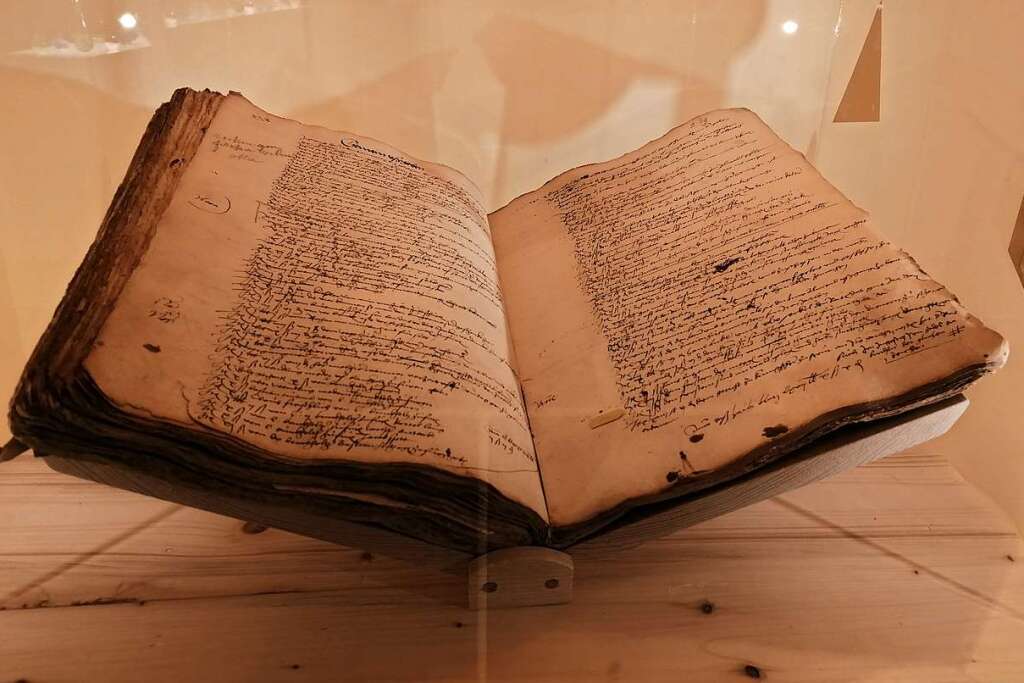The decorated Christmas tree is the most famous symbol of Christmas. An account book from Slestat from 1521 is considered to be the world’s oldest document describing the festival tree.
Fir trees have been decorating churches and homes at Christmas for centuries. It is celebrated in Alsace in a very special way this year. Because the little French town Slestat sees itself as the cradle of the Christmas tree tradition. It was not “invented” there, but it was first documented in writing 500 years ago.
“Item IIII Schillings to have the frstern die meyen on St. Thomas Day”, the accountant carefully noted on December 21, 1521 in the account book of Schlettstadt in Alsace, today’s Slestat. Four shillings should be paid to the forester who tended the firs (old German Meyen) of the community forest. It is further described there that the residents of the city can fill a fir tree free of charge to decorate them. The entry is considered to be the oldest document in the world in which the festival tree is mentioned.
The yellowed sheet is inventoried in the city archive under the number CC53 and is not publicly accessible. On the occasion of the 500th anniversary, however, it is currently on display in the Humanist Library in Slestat – in a display case that is modeled on a Christmas tree.
Further documents from Alsace
Another documentary evidence from 1539 also comes from Alsace and mentions a Christmas tree that was set up in the Straburg Cathedral. That is hardly surprising, explains the traditional researcher and Catholic theologian Manfred Becker-Huberti. Because the custom of putting up an evergreen tree originally comes from the church.
In the late Middle Ages, the paradise play was performed before the actual nativity play, which made it clear how sin came into the world through Adam and Eve. December 24th is also the day of remembrance for the first biblical human couple. A “tree of paradise” was part of this game. Evergreen trees such as holly or fir trees were used for this purpose. These were decorated with red apples.
Custom adopted
The subsequent nativity play illustrated the salvation of the people. With the birth of her son, Maria overcame the inherited sin as the “new Eva”, explains Becker-Huberti. This is also an explanation for the fact that once on paintings Mary and the baby Jesus were often depicted with an apple, as for example by Lucas Cranach the Elder in 1520/1530.
The church custom would soon have been adopted by the guilds and guilds: a tree was decorated with apples, wafers and toys, and the children were allowed to loot it. However, there is no historical evidence whatsoever for stories that as early as 1419 members of the bakeries from Freiburg im Breisgau had hung a Christmas tree with gingerbread, apples, fruits and nuts.
From Alsace to Hfe across Europe
At the end of the 16th century it was customary everywhere in Alsace to decorate a tree in the house for Christmas. This originally hung on a beam from the ceiling. Not only did it save space, but it should also prevent Muse from nibbling on it. It was decorated with red apples and white unconsecrated hosts, which were supposed to commemorate the redemption through Jesus’ death on the cross.
After that, the tradition of the Christmas tree quickly spread to royal and aristocratic harbors across Europe. The first Christmas tree decorated with candles dates back to 1611 in the Silesian castle of the Duchess Dorothea Sybille. It then entered literature in 1774 through Johann Wolfgang von Goethe. In his novel “The Sorrows of Young Werther” the poet describes the “tree decorated with wax lights, candy and apples”.
But it took a long time for the originally predominantly Protestant custom to become established among Catholics, says Becker-Huberti. Many Catholics continued to insist on the crib as a Christmas symbol. In many places, the Catholic Church initially protested against the setting up of Christmas trees.
Special postage stamp issued
Becker-Huberti reports that around 1900 the Christmas tree shone in the living rooms across all denominations. But it was not until 1982 that a Christmas tree was put up in St. Peter’s Square in Rome. Pope John Paul II introduced the custom.
In Slestat, the first mention of the Christmas tree is celebrated 500 years ago with numerous events and a small Christmas market in front of the humanistic library. A special postage stamp was issued by the French Post to mark the anniversary. And in front of the Sainte-Foy church in Slestat during these weeks there is a tall fir tree decorated in memory of old times: with shiny red Christmas balls in the shape of apples and white paper wafers with the golden inscription 1521.
–


